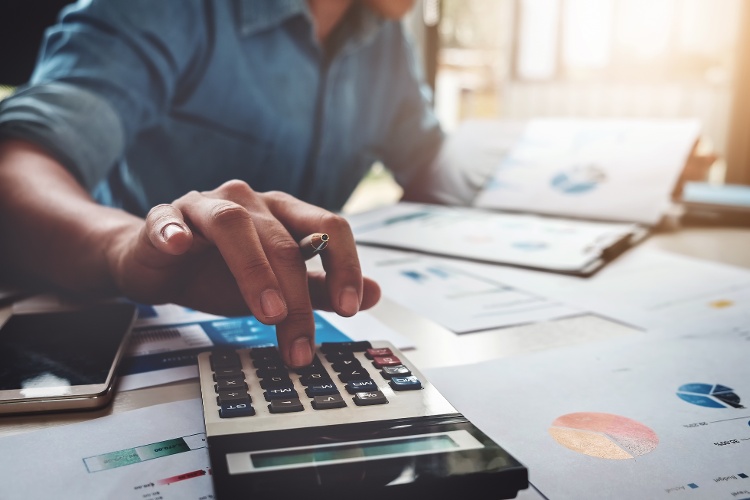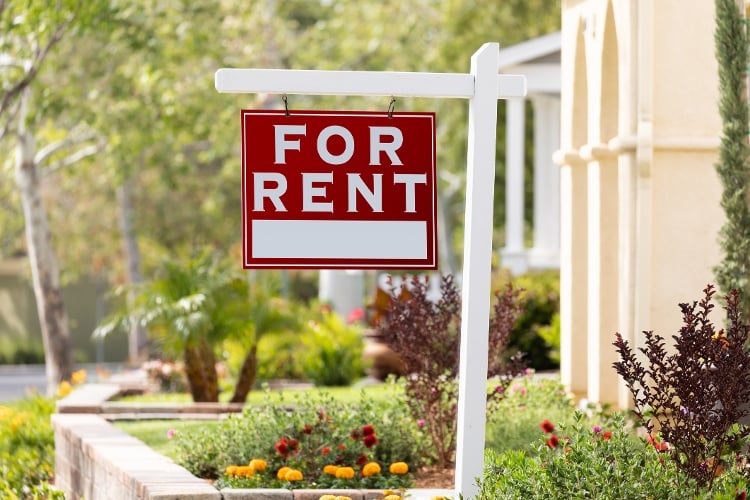Accurately calculating cash flow is the key to success for rental property investors.
Doing an accurate rental property cash flow analysis lets you focus your time and energy on deals that generate solid cash flow while avoiding money-losing property that could end up being cash flow negative.
What is Cash Flow?
Cash flow is a description of the way money flows through a rental property, similar to the way water flows over a waterfall.
Gross cash flow begins with rents and other income collected from a rental, is reduced by deducting normal operating expenses and debt service, and ends up as net cash flow that is subject to tax.
Higher levels of cash flow also help to reduce investment risk. That’s because there’s more money being generated from rental income to pay normal expenses, and also for unexpected repairs such as a broken water pipe in the middle of winter, or a major capital expense such as having to replace the HVAC.

How to Calculate Rental Property Cash Flow
There are four steps real estate investors follow to accurately predict rental property cash flow:
Step #1: Estimate gross cash flow/income
Your gross cash flow includes all money that comes in throughout the year:
- Gross rental income = $12,000 annual rent
- Additional income = $1,000 from sources such as pet rent, appliance rent, and application fees
- Vacancy (assuming a 6.5% vacancy rate) = - $780 from tenant turnover
- Gross Cash Flow = $12,220
Step #2: Forecast gross operating expenses
Gross operating expenses are money that goes out each year as a cost of owning and operating a rental property. Some of the most common expenses include:
- Leasing fees = $500
- Property management fees = $1,040
- Maintenance costs = $360
- CapEx (capital expenditures) reserve contributions = $600
- Insurance = $1,200
- Property tax = $1,500
- Gross Operating Expenses = $5,200
Step #3: Calculate NOI before financing
Next, calculate your net operating income (NOI) by subtracting your gross income from your gross operating expenses:
- NOI = Gross cash flow/income – Gross operating expenses
- $12,220 Gross cash flow/income - $5,200 Gross operating expenses = $7,020 NOI
Step #4: Calculate net cash flow after debt service
Let’s assume a $100,000 purchase price on a rental property using a conservative down payment of $25,000 and financing the remaining $75,000.
With a conventional 30-year mortgage at a fixed interest rate of 4%, the monthly mortgage payment is $358 (P&I). You annual net cash flow after debt service is:
- Net cash flow = NOI – Debt service
- $7,020 NOI - $4,296 Debt service ($358 monthly mortgage payment x 12 months) = $2,724 positive cash flow (or $238 in monthly cash flow)
Another good way to look at rental property cash flow is to compare it to a waterfall, such as Niagara Falls. Four of the Great Lakes provide the water that flows over Niagara Falls. Then, once the water falls over the Falls it travels to the St. Lawrence River, and eventually the Atlantic Ocean.
Your rental property is similar to the Great Lakes. The gross income provides the cash that flows, while you wait on a pristine beach in Florida for your personal share of the cash flow. Before your cash reaches you, much of it is used to “water” your rental property so that you’re not left high and dry:
- Collect rent and other income
- Pay normal operating expenses such as management, repairs, and insurance
- Pay the monthly mortgage
- Pay income taxes
- Pay yourself
As a real estate investor, your goal is to have as much liquid cash as possible at the bottom of your cash flow waterfall. Believe it or not, the IRS helps you to do just that, as we’ll see next.

How to Calculate Taxable Cash Flow
To understand the tax benefits that real estate investors receive, we’ll need to go back and calculate our net cash flow. That’s because two of the expenses we used to determine our net cash flow – CapEx contributions and the principal part of the mortgage payment - aren’t treated as expenses by the IRS.
Adjust your net cash flow
Begin by making the following adjustments to make to calculate pre-tax cash flow:
- Start with net cash flow = $2,724
- Add back CapEx deduction (because you’re setting aside the money, not spending it) = +$600
- Add back the principal part of your mortgage payment (because only the interest is deductible) = +$1,296
- Pre-tax cash flow = $4,620 ($2,724 net cash flow + $600 CapEx + $1,296 principal part of mortgage payment)
Deduct for depreciation
The next step in determining the taxable income from the rental property is to calculate your depreciation deduction.
The IRS allows you to depreciate the cost of a residential rental property (excluding the land value) over a period of 27.5 years. We’ll assume that the value of the lot on our $100,000 rental property is $15,000, which leaves a building value of $85,000 that is subject to depreciation:
- Depreciation expense = $85,000 / 27.5 years = $3,091
- Taxable cash flow = $4,620 (pre-tax cash flow) - $3,091 depreciation expense = $1,529
If you’re in the 22% tax bracket, you would pay $336 in federal taxes ($1,529 x 22%).
So, even though you really have a net cash flow of $2,724 going into your bank account (after making the full mortgage payment and CapEx contributions), according to the IRS your taxable income is only $1,529, thanks to the power of depreciation expense.
Now, let’s like at some additional rental property and business expenses you may be able to take to help reduce your taxable cash flow even more.

Typical Rental Property Expenses That Reduce Cash Flow
One of the most exciting things about owning a rental property is adding up the cash flow that’s coming in. However, where many investors make mistakes is by overlooking all of the costs of owning and operating a rental property.
Here’s a detailed look at typical rental property expenses that your property could have, depending on the type of property you own and how you run your real estate investing business:
- Vacancy expense (due to tenant turnover)
- Credit/bad debt expense (due to eviction)
- Leasing fees
- Property management fee
- Routine maintenance
- Repairs
- Landscaping
- Utilities (water, sewer, trash, gas, etc.)
- Appliance replacement
- CapEx (capital expense) account funding
- Capital repairs such as new HVAC or roof
- HOA monthly dues
- HOA special assessment
- Property insurance
- Landlord insurance (additional liability coverage for rental property)
- Rental tax
- Business license
- Advertising
- Office expenses
- Payroll expense (for W-2 employees)
- Continuing education (books, seminars, investor groups, etc.)
- Travel expenses
What is Considered “Good Cash Flow”?
Nearly all real estate investors own rental property for the recurring cash flow the investment provides. Unless you’re playing the high-risk game of fixing-and-flipping or wholesaling, as a real estate investor the more cash flow a property generates the better.
That’s because the more gross cash flow you have coming in from rents and additional services such as additional pet rent or appliance rental, the more money you’ll have to pay the operating expenses and mortgage. At the end of the day, you’ll also have more cash profit to add to your bank account.
However, one important thing to note is that you can typically see higher cash flowing properties in lower-income areas with higher risk, higher reward potential. So also keep that in mind as you’re analyzing properties.
Investors seeking to build a real estate portfolio of rental properties with high cash flow often look for Class C houses and multifamily properties in neighborhoods with average ratings of 2 or 3 stars. Also known as “cash cow” property, these investments may not appreciate that much over time, but the gross yields are in the double digits.
If you go to the Roofstock marketplace, then filter your search by “gross yield”, you’ll find rental property in working-class areas with yields of 16%, 17%, even 18%, or more. Tenant demand can be consistently strong, and renters tend to renew their leases year after year, which can keep vacancy loss low and minimize unnecessary expenses due to tenant turnover.
As you research different markets for rental property with good cash flow, keep in mind that cash flow can be either positive or negative. A cash flow positive property is one that generates more income than expenses. On the other hand, negative cash flow can occur when operating expenses and debt services exceed the amount of money coming in.
Conservative LTV
Leverage is a powerful tool real estate investors use to finance rental property without tying up too much of their own money as a down payment. However, just like eating too much of your favorite food and gaining weight, using too much leverage can inflate your expenses and leave you with very little net cash flow.
As a rule of thumb, a conservative loan-to-value (LTV) ratio is 75%. So, if you’re investing in a rental property priced at $100,000, you should plan on putting $25,000 down plus your normal closing costs. A conservative LTV keeps your monthly mortgage payment affordable, and your property cash flow positive, generating a steady profit each and every month.

Other Cash Calculations to Know
Three other common cash calculations used for rental property are the 1% Rule, the 50% Rule, and Cash-on-Cash return. We’ll use our rental property to explain how each one works:
1% Rule
The 1% Rule states that the gross monthly rent from an income property should be at least 1% of the property value:
- Gross monthly rent / Property value = 1% or more
- $1,000 gross monthly rent / $100,000 property value = .01 or 1%
Our property passes the test of the 1% Rule.
50% Rule
The 50% Rule states that a rental property’s net cash flow should be at least 50% of the gross rent less the mortgage payment (P&I):
- Net cash flow = (Gross rent x 50%) – Mortgage P&I
- ($12,000 gross annual rent x 50%) - $4,296 mortgage P&I = $1,704 per year
Our property passes the test of the 50% Rule because it is generating $2,724 in net cash flow.
Cash-on-Cash Return
The cash-on-cash return formula compares the cash invested in a rental property to the net cash flow being generated. In our example, we purchased the property with a $25,000 down payment and the net cash flow is $2,724:
- Cash-on-cash return = Net cash flow / Cash invested
- $2,724 net cash flow / $25,000 down payment = .109 or 10.9%
Generally speaking, many investors believe that a higher the cash-on-cash return of a rental property is better, provided that conservative leverage is being used.
Final Thoughts on Cash Flow
There’s an old saying that says, “Cash is king.” Now that you understand how to do a rental property cash flow analysis, you know how true those words really are.
Solid and predictable cash flow is the lifeblood for any rental property investor. High levels of cash flow ensure you’ll have the money to pay for operating expenses and loan payments, and will also help reduce your investment risk.









